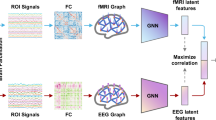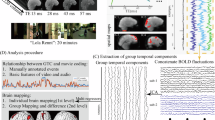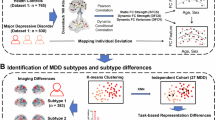Abstract
Studies using functional magnetic resonance imaging (fMRI) show predominant negative blood oxygenation level-dependent (BOLD) responses (NBRs) in regions of the default-mode network such as the pregenual anterior cingulate cortex, the ventromedial prefrontal cortex, and the posterior cingulate cortex. Patients with major depressive disorder (MDD) show emotional–cognitive disturbances, which have been associated with alterations within the default-mode network. However, it remains unclear whether these default-mode network alterations are related to abnormalities in NBRs. We therefore investigated neural activity in the default-mode network during different emotional tasks in patients with MDD in an event-related fMRI design. MDD patients showed significantly reduced NBRs in several regions of the default-mode network. Decreased NBRs in MDD patients correlated with depression severity and feelings of hopelessness. In sum, our findings demonstrate that default-mode network NBRs are reduced in MDD and modulate these patients' abnormally negative emotions.
Similar content being viewed by others
Log in or create a free account to read this content
Gain free access to this article, as well as selected content from this journal and more on nature.com
or
References
Anderson AK, Christoff K, Stappen I, Panitz D, Ghahremani DG, Glover G et al (2003). Dissociated neural representations of intensity and valence in human olfaction. Nat Neurosci 6: 196–202.
Beauregard M, Paquette V, Levesque J (2006). Dysfunction in the neural circuitry of emotional self-regulation in major depressive disorder. NeuroReport 17: 843–846.
Bechara A, Tranel D, Damasio H, Adolphs R, Rockland C, Damasio AR (1995). Double dissociation of conditioning and declarative knowledge relative to the amygdala and hippocampus in humans. Science 269: 1115–1118.
Beck AT, Ward CH, Mendelson M, Mock J, Erbaugh J (1961). An inventory for measuring depression. Arch Gen Psychiatry 4: 561–571.
Beck AT, Weissman A, Lester D, Trexler L (1974). The measurement of pessimism: the hopelessness scale. J Consult Clin Psychol 42: 861–865.
Bermpohl F, Fregni F, Boggio PS, Thut G, Northoff G, Otachi PTM et al (2006). Effect of low-frequency transcranial magnetic stimulation on an affective go/no-go task in patients with major depression: role of stimulation site and depression severity. Psychiatry Res 141: 1–13.
Canli T, Sivers H, Thomason ME, Whitfield-Gabrieli S, Gabrieli JD, Gotlib IH (2004). Brain activation to emotional words in depressed vs healthy subjects. NeuroReport 15: 2585–2588.
Davidson RJ, Irwin W, Anderle MJ, Kalin NH (2003). The neural substrates of affective processing in depressed patients treated with venlafaxine. Am J Psychiatry 160: 64–75.
Dunn RT, Kimbrell TA, Ketter TA, Frye MA, Willis MW, Luckenbaugh DA et al (2002). Principal components of the Beck depression inventory and regional cerebral metabolism in unipolar and bipolar depression. Biol Psychiatry 51: 387–399.
Fox MD, Snyder AZ, Vincent JL, Corbetta M, Van Essen DC, Raichle ME (2005). From the cover: the human brain is intrinsically organized into dynamic, anticorrelated functional networks. Proc Natl Acad Sci USA 102: 9673–9678.
Fox MD, Snyder AZ, Zacks JM, Raichle ME (2006). Coherent spontaneous activity accounts for trial-to-trial variability in human evoked brain responses. Nat Neurosci 9: 23–25.
Fransson P (2005). Spontaneous low-frequency BOLD signal fluctuations: an fMRI investigation of the resting-state default mode of brain function hypothesis. Hum Brain Mapp 26: 5–29.
Fu CHY, Williams SCR, Cleare AJ, Brammer MJ, Walsh ND, Kim J et al (2004). Attenuation of the neural response to sad faces in major depression by antidepressant treatment: a prospective, event-related functional magnetic resonance imaging study. Arch Gen Psychiatry 61: 877–889.
Greicius MD, Flores BH, Menon V, Glover GH, Solvason HB, Kenna H et al (2007). Resting-state functional connectivity in major depression: abnormally increased contributions from subgenual cingulate cortex and thalamus. Biol Psychiatry 62: 429–437.
Greicius MD, Srivastava G, Reiss AL, Menon V (2004). Default-mode network activity distinguishes Alzheimer's disease from healthy aging: evidence from functional MRI. Proc Natl Acad Sci USA 101: 4637–4642.
Grimm S, Beck J, Schuepbach D, Hell D, Boesiger P, Bermpohl F et al (2008). Imbalance between left and right dorsolateral prefrontal cortex in major depression is linked to negative emotional judgment: an fMRI study in severe major depressive disorder. Biol Psychiatry 63: 369–376.
Grimm S, Schmidt CF, Bermpohl F, Heinzel A, Dahlem Y, Wyss M et al (2006). Segregated neural representation of distinct emotion dimensions in the prefrontal cortex—an fMRI study. NeuroImage 30: 325–340.
Gusnard DA, Raichle ME, Raichle ME (2001). Searching for a baseline: functional imaging and the resting human brain. Nat Rev Neurosci 2: 685–694.
Hamilton M (1960). A rating scale for depression. J Neurol Neurosurg Psychiatry 23: 56–62.
Heinzel A, Bermpohl F, Niese R, Pfennig A, Pascual-Leone A, Schlaug G et al (2005). How do we modulate our emotions? Parametric fMRI reveals cortical midline structures as regions specifically involved in the processing of emotional valences. Cogn Brain Res 25: 348–358.
Kennedy SH, Evans KR, Kruger S, Mayberg HS, Meyer JH, McCann S et al (2001). Changes in regional brain glucose metabolism measured with positron emission tomography after paroxetine treatment of major depression. Am J Psychiatry 158: 899–905.
Kennedy SH, Konarski JZ, Segal ZV, Lau MA, Bieling PJ, McIntyre RS et al (2007). Differences in brain glucose metabolism between responders to CBT and venlafaxine in a 16-week randomized controlled trial. Am J Psychiatry 164: 778–788.
Kimbrell TA, Ketter TA, George MS, Little JT, Benson BE, Willis MW et al (2002). Regional cerebral glucose utilization in patients with a range of severities of unipolar depression. Biol Psychiatry 51: 237–252.
Lang PJ, Bradley MM, Cuthbert BN (1999). International Affective Picture System (IAPS) [Database].
Lawrence NS, Williams AM, Surguladze S, Giampietro V, Brammer MJ, Andrew C et al (2004). Subcortical and ventral prefrontal cortical neural responses to facial expressions distinguish patients with bipolar disorder and major depression. Biol Psychiatry 55: 578–587.
Lewis PA, Critchley HD, Rotshtein P, Dolan RJ (2006). Neural correlates of processing valence and arousal in affective words. Cereb Cortex 17 (3); 742–748.
Logan BR, Rowe DB (2004). An evaluation of thresholding techniques in fMRI analysis. NeuroImage 22: 95–108.
Mayberg H (2002). Depression, II: localization of pathophysiology. Am J Psychiatry 159: 1979.
Mayberg HS (2003). Modulating dysfunctional limbic–cortical circuits in depression: towards development of brain-based algorithms for diagnosis and optimised treatment. Br Med Bull 65: 193–207.
McKiernan KA, Kaufman JN, Kucera-Thompson J, Binder JR (2003). A parametric manipulation of factors affecting task-induced deactivation in functional neuroimaging. J Cogn Neurosci 15: 394–408.
Milak MS, Parsey RV, Keilp J, Oquendo MA, Malone KM, Mann JJ (2005). Neuroanatomic correlates of psychopathologic components of major depressive disorder. Arch Gen Psychiatry 62: 397–408.
Moran JM, Macrae CN, Heatherton TF, Wyland CL, Kelley WM (2006). Neuroanatomical evidence for distinct cognitive and affective components of self. J Cogn Neurosci 18: 1586–1594.
Murphy FC, Nimmo-Smith I and Lawrence AD (2003). Functional neuroanatomy of emotions: a meta-analysis. Cogn Affect Behav Neurosci 3: 207–233.
Northoff G, Heinzel A, Bermpohl F, Niese R, Pfennig A, Pascual-Leone A et al (2004). Reciprocal modulation and attenuation in the prefrontal cortex: an fMRI study on emotional–cognitive interaction. Hum Brain Mapp 21: 202–212.
Oldfield RC (1971). The assessment and analysis of handedness: the Edinburgh inventory. Neuropsychologia 9: 97–113.
Ollinger JM, Shulman GL, Corbetta M (2001). Separating processes within a trial in event-related functional MRI. NeuroImage 13: 210–217.
Phan KL, Taylor SF, Welsh RC, Ho SH, Britton JC, Liberzon I (2004). Neural correlates of individual ratings of emotional salience: a trial-related fMRI study. NeuroImage 21: 768–780.
Phillips ML, Drevets WC, Rauch SL, Lane R (2003). Neurobiology of emotion perception II: implications for major psychiatric disorders. Biol Psychiatry 54: 515–528.
Price CJ, Friston KJ (1997). Cognitive conjunction: a new approach to brain activation experiments. NeuroImage 5: 261–270.
Pruessmann KP, Weiger M, Scheidegger MB, Boesiger P (1999). SENSE: sensitivity encoding for fast MRI. Magn Reson Med 42: 952–962.
Raes F, Hermans D, Williams JM, Demyttenaere K, Sabbe B, Pieters G et al (2006). Is overgeneral autobiographical memory an isolated memory phenomenon in major depression? Memory 14: 584–594.
Raichle ME, Gusnard DA (2005). Intrinsic brain activity sets the stage for expression of motivated behavior. J Comp Neurol 493: 167–176.
Raichle ME, MacLeod AM, Snyder AZ, Powers WJ, Gusnard DA, Shulman GL (2001). A default mode of brain function. Proc Natl Acad Sci USA 98: 676–682.
Rajkowska G (2002). Cell pathology in mood disorders. Semin Clin Neuropsychiatry 7: 281–292.
Rajkowska G (2003). Depression: what we can learn from postmortem studies. Neuroscientist 9: 273–284.
Rimes KA, Watkins E (2005). The effects of self-focused rumination on global negative self-judgements in depression. Behav Res Ther 43: 1673–1681.
Robertson B, Wang L, Diaz MT, Aiello M, Gersing K, Beyer J et al (2007). Effect of bupropion extended release on negative emotion processing in major depressive disorder: a pilot functional magnetic resonance imaging study. J Clin Psychiatry 68: 261–267.
Schmidt CF, Boesiger P and Ishai A (2005). Comparison of fMRI activation as measured with gradient- and spin-echo EPI during visual perception. Neuroimage 26: 852–859.
Simpson SW, Baldwin RC, Burns A, Jackson A (2001). Regional cerebral volume measurements in late-life depression: relationship to clinical correlates, neuropsychological impairment and response to treatment. Int J Geriatr Psychiatry 16: 469–476.
Stark CE, Squire LR (2001). When zero is not zero: the problem of ambiguous baseline conditions in fMRI. Proc Natl Acad Sci USA 98: 12760–12766.
Surguladze SA, Young AW, Senior C, Brebion G, Travis MJ, Phillips ML (2005). Recognition accuracy and response bias to happy and sad facial expressions in patients with major depression. Neuropsychology 18: 212–218.
Wager TD, Phan KL, Liberzon I, Taylor SF (2003). Valence, gender, and lateralization of functional brain anatomy in emotion: a meta-analysis of findings from neuroimaging. Neuroimaage 19: 513–531.
Treynor W (2003). Rumination reconsidered: a psychometric analysis. Cogn Ther Res 27: 247–259.
Acknowledgements
The study was supported by a Heisenberg grant from the German Research Foundation (DFG, 304/4-1 to GN), the Swiss National Research Foundation (3100A0-100830) to GN and HB, a grant of the Research Foundation at the University of Zurich, Organon, Switzerland, to GN and HB, a grant of the Salus Foundation Sachsen Anhalt/Germany to GN, a grant from ETH Zurich (SEP) and Philips Medical Systems, Best, NL, to PB, the Hartmann-Müller-Foundation to HB/GN, the Gebert-Rüf-Foundation to HB/GN, and the German Federal Ministry of Education and Research (BMBF-01GWSO61 to FB) as well as a grant from the Hope of Depression Research Foundation (HDRF/ISAN) to GN.
Author information
Authors and Affiliations
Corresponding author
Additional information
DISCLOSURE/CONFLICT OF INTEREST
The authors report no conflict of interests.
Rights and permissions
About this article
Cite this article
Grimm, S., Boesiger, P., Beck, J. et al. Altered Negative BOLD Responses in the Default-Mode Network during Emotion Processing in Depressed Subjects. Neuropsychopharmacol 34, 932–943 (2009). https://doi.org/10.1038/npp.2008.81
Received:
Revised:
Accepted:
Published:
Issue date:
DOI: https://doi.org/10.1038/npp.2008.81
Keywords
This article is cited by
-
Brain-wide changes in excitation-inhibition balance of major depressive disorder: a systematic review of topographic patterns of GABA- and glutamatergic alterations
Molecular Psychiatry (2023)
-
Abnormal global signal topography of self modulates emotion dysregulation in major depressive disorder
Translational Psychiatry (2023)
-
Altered brain dynamic in major depressive disorder: state and trait features
Translational Psychiatry (2023)
-
Brain functional connectivity in children with developmental coordination disorder following rehabilitation intervention
Pediatric Research (2022)
-
Combination of structural MRI, functional MRI and brain PET-CT provide more diagnostic and prognostic value in patients of cerebellar ataxia associated with anti-Tr/DNER: a case report
BMC Neurology (2021)



